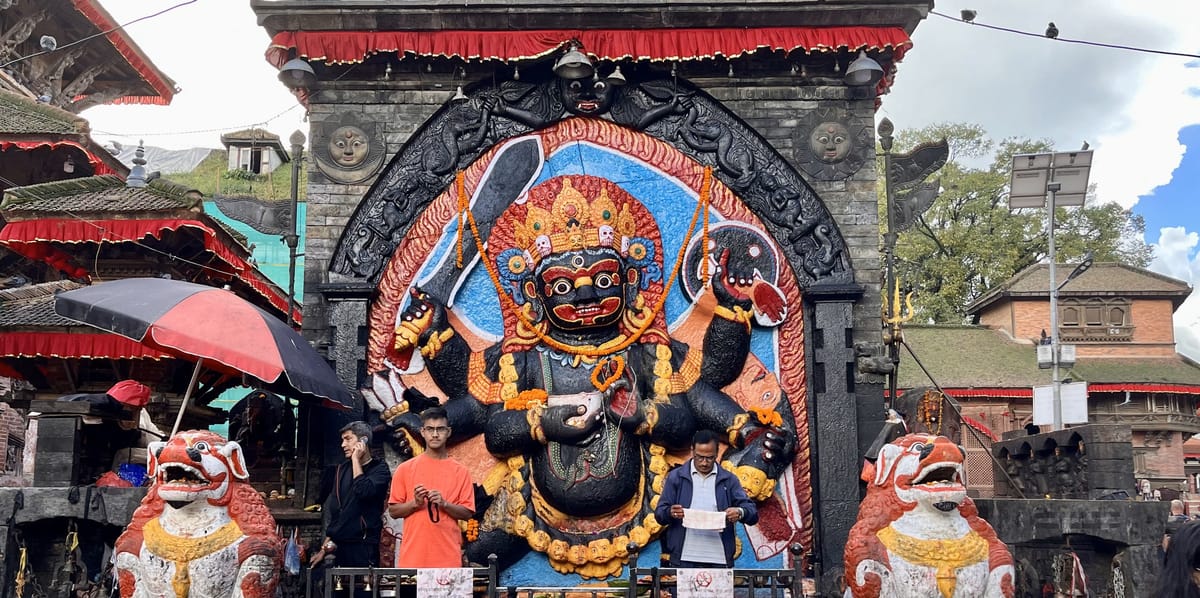Witnessing Life, Death, and Faith Through the Temples of Kathmandu

When you see or hear the name of the city Kathmandu, visions of something mystical, spiritual, and exotic probably spring into your imagination. Surely, in this day and age it's more myth than reality, right?
But after riding through its chaotic streets on a tuk tuk/rickshaw and arriving in Darbur Square just as men were dragging the headless bodies of two buffaloes out of the 16th-century shrine at Mul Chowk of Goddess Taleju Bhawani, I realized sometimes the myth is the reality.
Unplanned by me, I’d arrived in Kathmandu on the 9th day of the Dashain festival which is the one day each year the Taleju Bhawani Temple opens its doors for animal sacrifices. It was fortuitous timing because it also meant I was there the one day a year the 17th-century Kumari Temple is open. It is the official residence of the Royal Kumari of Kathmandu, a pre-pubesent girl believed to be a living goddess, the incarnation of Taleju, a manifestation of the goddess Durga. A long line of the local Hindu Buddhist community was waiting to see her and secure her blessing.
The Taleju and Kumari Temples are just two of 50 temples that lie in the vicinity of Durbar Square. While I often like to explore on my own, this was a place where I was glad I paid what was a small amount to me, but probably a welcomed income to them, for a local guide who was pitching his services as soon as I exited my tuk tuk. The money spent on the guide was worth it just to hear him very matter-of-factly and with a straight face explain in detailed English the erotic wood carvings on the Jagannath, aka Kama Sutra Temple, while I tried not to laugh like a 12-year-old boy.
I’d come to Nepal for a five-day trek on the Annapurna Circuit of the Himalayas, but two days in Kathmandu bookended that adventure, and I was determined to see as much of the city as possible. Signs of the 2015 earthquake damage were still quite visible in the scaffolding around several buildings in Durbar Square and in other locations I passed while walking/wandering back to my hotel.
Temples or shrines are not limited to that prominent area. On any random street corner, under a massive entanglement of utility wires that I can’t believe keep the lights on, you can find a shrine to one of the hundreds of gods the predominantly Hindu population worships. Even the Bodhi tree next to the entrance of my hotel was festooned in prayer flags, and an array of flower offerings was constantly refreshed at its base. (According to Buddist tradition, the Buddha was sitting under a Bodhi tree when he attained Enlightenment.)
But there are several large temples outside of Durbar Square, and my awesome expedition partner Prime Himalayas booked another tour guide for me with a car so that I could squeeze in visits to several of them on my final day in the city.
This included the Swayambhunath Stupa, also known as the Monkey Temple because of the many monkeys who make their home on its grounds. There seemed to be about as many dogs as monkeys there, though. I guess word gets around the animal kingdom when there are places where tourists likely drop a lot of edible items.
Different from a temple you go inside, a stupa is a closed, dome-shaped structure that serves as a Buddhist shrine and often contains relics attributed to the Buddha. You worship by walking around it, and although I’m not Buddhist, I gave the prayer wheels a turn and lifted up my own mantra as I circled the site that both Hindus and Buddhists revere.
My final stop that day was a place that is the ultimate final stop for many. The Pashupatinath Temple. It is noted as the most revered Hindu temple in Nepal. It sits on the banks of the River Bagmati, which ultimately joins the Ganges in India. Non-Hindus are not permitted inside the temple, but you can walk the grounds around it, and from the terraces across the river, you can observe the cremation of fallen faithful where their ashes can float down the holy river.
I, too, have plans for my ashes to one day float down a river (the Mississippi, if you wonder), but I won’t be able to go out with all the ceremony of the Nepalese families who mourn at Pashupatinath under the gaze of locals and tourists alike.
I appreciate them allowing me this respectfully distant look into their intimate moments. I appreciate the warm welcome so many Nepalese gave me into the other aspects of their lives, too.
And as I continue to travel my own path to enlightenment, I carry a little bit of them with me every day in the unalome tattoo I brought back with me – shout out to Anjit Tattoo!